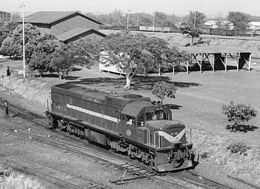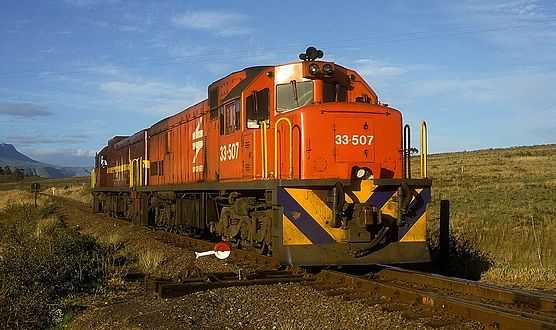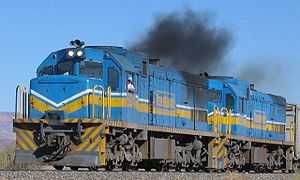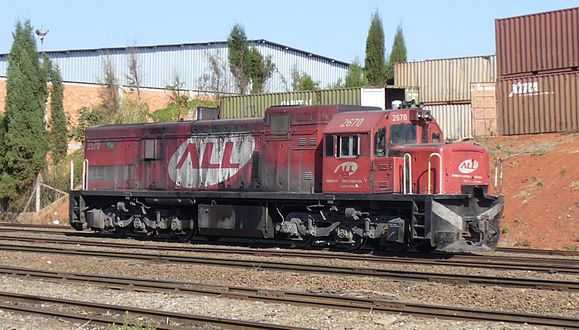South African Class 33-400
| South African Class 33-400 | |
|---|---|
|
Rebuilt TransNamib no. 504, ex no. 33-475, near Keetmanshoop, Namibia, on 2 September 2004 | |
| Type and origin | |
| Power type | Diesel-electric |
| Designer | General Electric |
| Builder | SA GE-DL Locomotive Group |
| Serial number | 36530-36644 [1] |
| Model | GE U20C |
| Build date | 1968-1970 |
| Total produced | 115 |
| Specifications | |
| AAR wheel arr. | C+C |
| UIC classification | Co'Co' (Co+Co interlinked bogies) |
| Gauge | 3 ft 6 in (1,067 mm) Cape gauge |
| Bogies | 3.505 m (11 ft 6 in) wheelbase |
| Wheel diameter | 915 mm (36 in) |
| Wheelbase | 12.243 m (40 ft 2 in) |
| Length | 16.866 m (55 ft 4 in) |
| Width | 2.756 m (9 ft 0.5 in) |
| Height | 3.931 m (12 ft 10.8 in) |
| Axle load | 15,749 kg (15.5 long tons) |
| Locomotive weight |
91,000 kg (89.6 long tons) average 94,494 kg (93.0 long tons) maximum |
| Fuel type | Fuel oil |
| Fuel capacity | 3,600 litres (951 US gal) |
| Prime mover | GE 7FDL-12 4 stroke V12 |
| Engine RPM range |
400 rpm idle 1,000 rpm maximum |
| Engine type | Diesel |
| Aspiration | Cooper-Bessemer ET13 turbocharger |
| Generator | DC 10 pole GE 5GT-581C9 |
| Traction motors |
Six GE 5GE-761A6 DC 4 pole * 635A rating 1 hour * 620A rating continuous at 20 km/h (12 mph) |
| Transmission | 92/19 gear ratio |
| Multiple working | 6 maximum |
| Performance figures | |
| Maximum speed | 100 km/h (62 mph) |
| Power output |
1,605 kW (2,152 hp) starting 1,490 kW (2,000 hp) continuous |
| Tractive effort |
223 kN (50,000 lbf) starting 178 kN (40,000 lbf) continuous at 24 km/h (15 mph) |
| Factor of adhesion |
25% starting 20% continuous |
| Locomotive brake |
28L-AV-1 with vigilance control Dynamic brake peak effort: 173 kN (39,000 lbf) at 26 km/h (16 mph) |
| Locomotive brakeforce | 70% ratio at 345 kPa (50.0 psi) brake cylinder pressure |
| Train brakes |
825 litres (218 US gal) main reservoir Compressor capacity at idle: 0.029 m3/s (1.0 cu ft/s) Exhauster capacity at idle: 0.116 m3/s (4.1 cu ft/s) |
| Career | |
| Operator(s) |
South African Railways Spoornet TransNamib Transnet Freight Rail Ferrovia Centro-Atlântica (Brazil) América Latina Logística (Brazil) Ferroviaria Oriental (Bolivia) Sociedad Química y Minera (Chile) Kumba Iron Ore Sudan Railways Zambia Railways [1] |
| Class | Class 33-400 [2] |
| Number in class | 115 |
| Number(s) | 33-401 to 33-515 |
| Nicknames | Bosvark |
| Delivered | 1968-1970 |
| First run | 1968 |
The South African Class 33-400 of 1968 is a South African diesel-electric locomotive from the South African Railways era.
Between July 1968 and March 1970 the South African Railways placed one hundred and fifteen Class 33-400 General Electric type U20C diesel-electric locomotives in service. A large number of them were transferred to TransNamib, the Namibian Railways, upon South West Africa’s independence on 21 March 1990.[2]
Manufacturer
The Class 33-400 type GE U20C diesel-electric locomotive was designed for the South African Railways (SAR) by General Electric (GE) and built by the South African General Electric-Dorman Long Locomotive Group (SA GE-DL, later Dorbyl). One hundred and fifteen locomotives were delivered between July 1968 and March 1970, numbered in the range from 33-401 to 33-515.[2]
Class 33 series
The Class 33 consists of three series, the GE Class 33-000 and Class 33-400 and the General Motors Electro-Motive Division Class 33-200. Both these manufacturers also produced locomotives for the subsequent SAR Classes 34, 35 and 36.[3]
Service
South African Railways
A large number of the Class 33-400 locomotives were placed in service in South West Africa (SWA) upon being commissioned. Forty-five of them were eventually transferred to TransNamib, the Namibian Railways, upon SWA’s independence on 21 March 1990. They retained their SAR engine numbers on the TransNamib roster, but without the "33-" prefix. Some have since been sold, while others have been rebuilt with reconditioned engines by TransNamib in Windhoek and renumbered from number 501 up.[1]
In South Africa, most of the Class 33-400 locomotives survived in mainline and branchline service well into the 21st century, for example on the lines from De Aar to Upington, from Worcester to George and on suburban service out of East London. From 2009 some were also employed out of Cape Town on the Overberg line across Sir Lowry’s Pass to Caledon and on the Bitterfontein line up the West Coast, where they replaced several Class 35-000 and 35-400 locomotives that were leased to private railway operators in several Southern African countries.
Some were employed for a while as heavy shunters to assemble or unload iron ore trains at the Sishen-Saldanha iron ore route's terminals, until the arrival of the Class 15E in 2010 made more Class 34-000 locomotives available for this task.[1]
Zambia
Between October 1978 and May 1993 Zambia Railways (ZR) hired locomotives to solve it's chronic shortages in motive power, mainly from South Africa but at times also from Zaire, Zimbabwe, the TAZARA Railway and even the Zambian Copper Mines. In Zambia the South African locomotives were mainly used on goods trains between Livingstone and Kitwe, sometimes in tandem with a ZR locomotive and occasionally also on passenger trains.[4]

Locomotives were selected from a float of engines that were allocated by the Railways for hire to Zambia. The South African fleet in Zambia was never constant since locomotives were continually exchanged as they became due back in South Africa for their three-monthly services. The locomotives were initially selected from the Classes 33-400, 35-000 and 35-200, but by December 1989 some Class 33-000 locomotives also began to serve one or more tours of duty in Zambia.[4]
The float of Class 33-400 locomotives allocated by the Railways for hire to ZR from time to time included the locomotives as shown in the "leased to" column in the table below. The last Class 33-400 locomotive to serve in Zambia was no. 33-491 that was returned in April 1992, and by the end of May 1993 no more South African locomotives were working in Zambia.[4]
Industrial service
Six Class 33-400 locomotives were sold to Iscor (now Kumba Iron Ore) for use at its Vanderbijlpark steel works and at Kumba’s Grootgeluk Colliery at Ellisras.[1]
South America
Twenty Class 33-400 locomotives were sold in 1997 to Ferrovia Centro-Atlântica (FCA) and were since resold, in 1999, to América Latina Logística (ALL) in Brazil, where they retained their FCA engine numbers.[1]
Three of these locomotives, ex SAR numbers 33-410 (ALL 2663), 33-452 (2668) and 33-481 (2679), were resold to the Ferroviaria Oriental (FOB) in Bolivia in 2003. Of these, one was resold again to Empresa Ferroviaria Oriental (EFO) in Bolivia and the other two to Sociedad Química y Minera (SQM) in Chile.[1][5][6]
Of these twenty locomotives in South America, ten still survived by July 2010. These include the three units sold to FOB and subsequently resold to EFO and SQM, five locomotives reported as non-operating and two that were returned to Rede Ferroviária Federal, Sociedade Anônima, (RFFSA), the state-owned federal railroad network of Brazil.[5]
Sudan Railways
Ten Class 33-400 locomotives were sold to the Sudan Railways.[1]
Works numbers
The Class 33-400 builder’s works numbers and eventual disposition are listed in the table.[1]
SAR no. |
Works no. |
Leased to |
Post-SAR owner |
Post-SAR no. |
Rebuilt, or Resold to: |
Rebuilt or Resold no. |
|---|---|---|---|---|---|---|
| 33-401 | 36530 | FCA & ALL | 2670 | |||
| 33-402 | 36531 | TransNamib | 402 | |||
| 33-403 | 36532 | Zambia | Sudan | |||
| 33-404 | 36533 | Sudan | ||||
| 33-405 | 36534 | TransNamib | 405 | |||
| 33-406 | 36535 | Zambia | Sudan | |||
| 33-407 | 36536 | Zambia | TransNamib | 407 | TransNamib | 508 |
| 33-408 | 36537 | Sudan | ||||
| 33-409 | 36538 | Sudan | ||||
| 33-410 | 36539 | FCA & ALL | 2663 | FOB & EFO | 2009 | |
| 33-411 | 36540 | Sudan | ||||
| 33-412 | 36541 | TransNamib | 412 | |||
| 33-413 | 36542 | TransNamib | 413 | |||
| 33-414 | 36543 | TransNamib | 414 | TransNamib | 503 | |
| 33-415 | 36544 | Sudan | ||||
| 33-416 | 36545 | TransNamib | 416 | |||
| 33-417 | 36546 | TransNamib | 417 | |||
| 33-418 | 36547 | |||||
| 33-419 | 36548 | TransNamib | 419 | TransNamib | 507 | |
| 33-420 | 36549 | |||||
| 33-421 | 36550 | Zambia | FCA & ALL | 2661 | ||
| 33-422 | 36551 | Zambia | TransNamib | 422 | TransNamib | 505 |
| 33-423 | 36552 | Zambia | FCA & ALL | 2680 | ||
| 33-424 | 36553 | Sudan | ||||
| 33-425 | 36554 | Zambia | TransNamib | 425 | TransNamib | 509 |
| 33-426 | 36555 | |||||
| 33-427 | 36556 | Zambia | TransNamib | 427 | ||
| 33-428 | 36557 | FCA & ALL | 2666 | |||
| 33-429 | 36558 | Zambia | FCA & ALL | 2665 | ||
| 33-430 | 36559 | TransNamib | 430 | |||
| 33-431 | 36560 | TransNamib | 431 | |||
| 33-432 | 36561 | TransNamib | 432 | |||
| 33-433 | 36562 | FCA & ALL | 2672 | |||
| 33-434 | 36563 | TransNamib | 434 | TransNamib | 502 | |
| 33-435 | 36564 | TransNamib | 435 | |||
| 33-436 | 36565 | Kumba E | 7 | |||
| 33-437 | 36566 | Zambia | TransNamib | 437 | ||
| 33-438 | 36567 | FCA & ALL | 2669 | |||
| 33-439 | 36568 | Zambia | FCA & ALL | 2677 | ||
| 33-440 | 36569 | Zambia | Sudan | |||
| 33-441 | 36570 | Zambia | TransNamib | 441 | ||
| 33-442 | 36571 | Zambia | TransNamib | 442 | ||
| 33-443 | 36572 | Zambia | TransNamib | 443 | ||
| 33-444 | 36573 | TransNamib | 444 | |||
| 33-445 | 36574 | Zambia | TransNamib | 445 | ||
| 33-446 | 36575 | Zambia | TransNamib | 446 | ||
| 33-447 | 36576 | TransNamib | 447 | |||
| 33-448 | 36577 | FCA & ALL | 2664 | |||
| 33-449 | 36578 | Zambia | FCA & ALL | 2678 | ||
| 33-450 | 36579 | Sudan | ||||
| 33-451 | 36580 | FCA & ALL | 2671 | |||
| 33-452 | 36581 | FCA & ALL | 2668 | FOB & SQM | 4 or 5 | |
| 33-453 | 36582 | TransNamib | 453 | TransNamib | 501 | |
| 33-454 | 36583 | Kumba V | 67 | |||
| 33-455 | 36584 | Zambia | TransNamib | 455 | TransNamib | 506 |
| 33-456 | 36585 | Kumba E | 4 | |||
| 33-457 | 36586 | Zambia | TransNamib | 457 | ||
| 33-458 | 36587 | FCA & ALL | 2675 | |||
| 33-459 | 36588 | TransNamib | 459 | |||
| 33-460 | 36589 | Zambia | TransNamib | 460 | ||
| 33-461 | 36590 | Kumba V | 68 | |||
| 33-462 | 36591 | Kumba V | 69 | |||
| 33-463 | 36592 | Zambia | TransNamib | 463 | ||
| 33-464 | 36593 | TransNamib | 464 | |||
| 33-465 | 36594 | TransNamib | 465 | |||
| 33-466 | 36595 | FCA & ALL | 2676 | |||
| 33-467 | 36596 | |||||
| 33-468 | 36597 | TransNamib | 468 | |||
| 33-469 | 36598 | FCA & ALL | 2674 | |||
| 33-470 | 36599 | TransNamib | 470 | |||
| 33-471 | 36600 | Kumba E | 5 | |||
| 33-472 | 36601 | TransNamib | 472 | |||
| 33-473 | 36602 | TransNamib | 473 | |||
| 33-474 | 36603 | TransNamib | 474 | |||
| 33-475 | 36604 | TransNamib | 475 | TransNamib | 504 | |
| 33-476 | 36605 | TransNamib | 476 | |||
| 33-477 | 36606 | FCA & ALL | 2673 | |||
| 33-478 | 36607 | TransNamib | 478 | TransNamib | 511 | |
| 33-479 | 36608 | TransNamib | 479 | |||
| 33-480 | 36609 | TransNamib | 480 | |||
| 33-481 | 36610 | FCA & ALL | 2679 | FOB & SQM | 4 or 5 | |
| 33-482 | 36611 | FCA & ALL | 2662 | |||
| 33-483 | 36612 | TransNamib | 483 | |||
| 33-484 | 36613 | TransNamib | 484 | TransNamib | 510 | |
| 33-485 | 36614 | FCA & ALL | 2667 | |||
| 33-486 | 36615 | Zambia | ||||
| 33-487 | 36616 | Zambia | ||||
| 33-488 | 36617 | Zambia | ||||
| 33-489 | 36618 | Zambia | ||||
| 33-490 | 36619 | Zambia | ||||
| 33-491 | 36620 | Zambia | ||||
| 33-492 | 36621 | Zambia | ||||
| 33-493 | 36622 | Zambia | ||||
| 33-494 | 36623 | Zambia | ||||
| 33-495 | 36624 | Zambia | ||||
| 33-496 | 36625 | Zambia | ||||
| 33-497 | 36626 | Zambia | ||||
| 33-498 | 36627 | Zambia | ||||
| 33-499 | 36628 | Zambia | ||||
| 33-500 | 36629 | Zambia | ||||
| 33-501 | 36630 | Zambia | ||||
| 33-502 | 36631 | Zambia | ||||
| 33-503 | 36632 | Zambia | ||||
| 33-504 | 36633 | Zambia | ||||
| 33-505 | 36634 | Zambia | ||||
| 33-506 | 36635 | Zambia | ||||
| 33-507 | 36636 | Zambia | ||||
| 33-508 | 36637 | Zambia | ||||
| 33-509 | 36638 | Zambia | ||||
| 33-510 | 36639 | Zambia | ||||
| 33-511 | 36640 | Zambia | ||||
| 33-512 | 36641 | Zambia | ||||
| 33-513 | 36642 | Zambia | ||||
| 33-514 | 36643 | Zambia | ||||
| 33-515 | 36644 | Zambia | ||||
Number plates and liveries
The two cabside number plates on Class 33-400 locomotives were not identical. Usually all the locomotives in a Class would have either Afrikaans or English at the top of all their number plates. On the Class 33-400's number plates the inscription was in Afrikaans at the top on the right or driver’s side and in English at the top on the left or driver's assistant's side.
The main picture shows Namibia’s TransNamib livery, with ex SAR no. 33-475, now TransNamib’s rebuilt no. 504, south of Keetmanshoop on 2 September 2004. Some of the other liveries that were applied to Class 33-400 locomotives are illustrated below.
-
No. 33-488 in SAR Gulf Red and whiskers livery at East London, 24 April 2013
-

No. 33-507, the only known locomotive of the Class in Spoornet orange livery, at Swellendam, 20 August 2001
-
No. 33-500 in Transnet Freight Rail livery at Germiston diesel depot, Gauteng, 1 May 2013
See also
- Diesel-electric locomotive numbering and classification
- List of South African locomotive classes
- South African Class 33-000 (GE)
- South African Class 33-200 (GM-EMD)
- South African locomotive history
References
|
- ↑ 1.0 1.1 1.2 1.3 1.4 1.5 1.6 1.7 1.8 Middleton, John N. (2002). Railways of Southern Africa Locomotive Guide - 2002 (as amended by Combined Amendment List 4, January 2009) (2nd, Dec 2002 ed.). Herts, England: Beyer-Garratt Publications. pp. 38–39, 45, 47, 66.
- ↑ 2.0 2.1 2.2 South African Railways Index and Diagrams Electric and Diesel Locomotives, 610mm and 1065mm Gauges, Ref LXD 14/1/100/20, 28 January 1975, as amended
- ↑ Paxton, Leith; Bourne, David (1985). Locomotives of the South African Railways (1st ed.). Cape Town: Struik. pp. 139–140. ISBN 0869772112.
- ↑ 4.0 4.1 4.2 Spoornet Diesels Leased to ZR 1978-1993. P.F. Bagshawe.
- ↑ 5.0 5.1 Ex SAR 33-401 as ALL 2670
- ↑ Friends of the Rail
| ||||||||||||||||||||||||||||||||||||||||||



